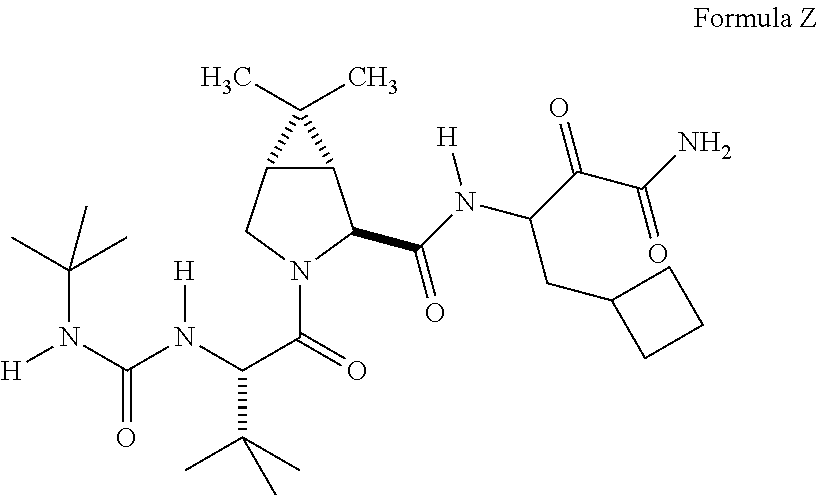Process for the synthesis of 3-amino-3-cyclobuthylmethyl-2-hydroxypropionamide or salts thereof
a technology of 3-amino-3-cyclobutylmethyl and 2-hydroxypropionamide, which is applied in the preparation of carboxylic acid amides, chemistry apparatus and processes, and organic chemistry, can solve the problem of relatively low product yield, and achieve the effect of reducing or eliminating the amount of cyanide-bearing waste generated, reducing the decomposition of intermediate compounds, and reducing the amount of cyanide-bearing was
- Summary
- Abstract
- Description
- Claims
- Application Information
AI Technical Summary
Benefits of technology
Problems solved by technology
Method used
Image
Examples
examples
[0078]Unless otherwise stated, the following abbreviations have the stated meanings in the Examples below:
MHz=Megahertz
NMR=nuclear magnetic resonance spectroscopy
mL=milliliters
g=grams
THF=tetrahydrofuran
TEMPO=2,2,6,6-Tetramethyl-1-piperidinyloxy radical
DMSO=dimethylsulfoxide
TBME=t-butylmethyl ether
t-Boc=t-butoxycarbonate
example i
TEMPO Mediated Oxidation of Compound Va to Compound VIa in Dichloromethane
[0079]
[0080]To a solution made from 100 g of 2-t-butoxycarbonylamino-3-cyclobutyl-1-propanol (the compound of Formula Va, provided in accordance with the procedures described in U.S. Pat. No. 6,992,220) dissolved in 650 mL of dichloromethane, which was cooled to (−4)° C., was added a slurry made adding 22.5 g of sodium bromide (0.5 equivalent) and 55 g of sodium bicarbonate (1.5 equivalent) to 80 ml water. To the resulting mixture was added a solution made by dissolving 0.25 g of 2,2,6,6-Tetramethyl-1-piperidinyloxy, free radical (TEMPO reagent) in 3 mL of dichloromethane. The reaction mixture was cooled to (−4)° C., and stirred for 10 minutes. At the end of the stirring period, 525 mL of a 5.5 wt. % aqueous sodium hypochlorite was added over a 1.5 hour period (hypochlorite activity titrated to be 1.0 equivalent) while maintaining the reaction mixture temperature between (−5)° C. and 0° C. The mixture was then...
example ii
One Pot Synthesis of Compound VIIIa from Compound VIa Using DMSO Reaction Media
[0081]
[0082]An amount of a methylene chloride solution of the Compound VIa prepared in Example I which was found by HPLC to contain 17.44 g of the compound of Formula VIa in methylene chloride prepared in the previous example was concentrated under vacuum (60-80 torr) to a minimum volume while maintaining a batch temperature below 25° C. (concentration was discontinued when distillation at 25° C. ceased). When distillation had stopped, to the concentrate was added 59 mL of DMSO. The mixture was concentrated again under the same condition (60-80 torr, maintaining the reaction mixture below 25° C.) until no methylene chloride was detected in the mixture by NMR. To the reaction mixture (the solvent of which substantially comprised. DMSO) was added 7.8 mL of acetone cyanohydrin (Aldrich, used as received) followed by 0.3 g of potassium carbonate. The reaction mixture is agitated at room temperature for 16 hou...
PUM
| Property | Measurement | Unit |
|---|---|---|
| temperature | aaaaa | aaaaa |
| pressure | aaaaa | aaaaa |
| temperature | aaaaa | aaaaa |
Abstract
Description
Claims
Application Information
 Login to View More
Login to View More - R&D
- Intellectual Property
- Life Sciences
- Materials
- Tech Scout
- Unparalleled Data Quality
- Higher Quality Content
- 60% Fewer Hallucinations
Browse by: Latest US Patents, China's latest patents, Technical Efficacy Thesaurus, Application Domain, Technology Topic, Popular Technical Reports.
© 2025 PatSnap. All rights reserved.Legal|Privacy policy|Modern Slavery Act Transparency Statement|Sitemap|About US| Contact US: help@patsnap.com



